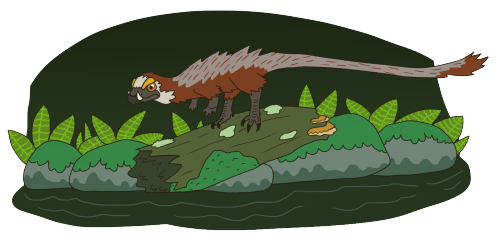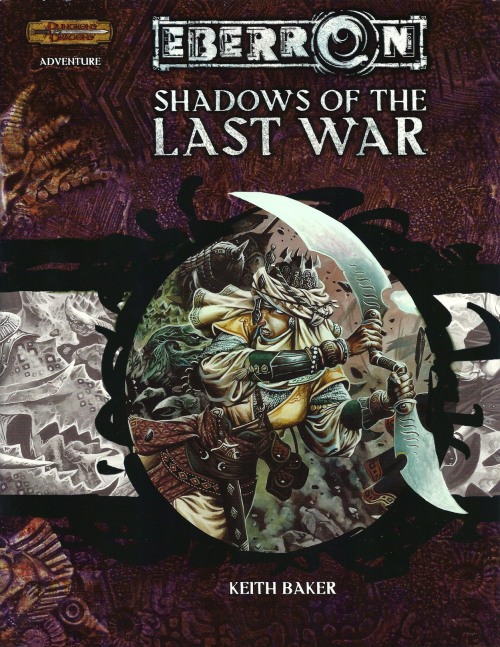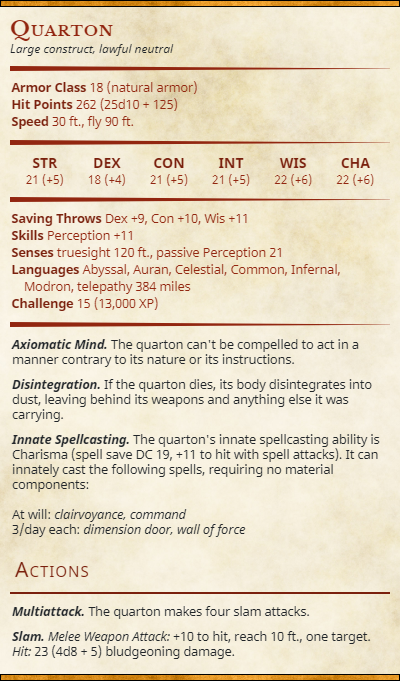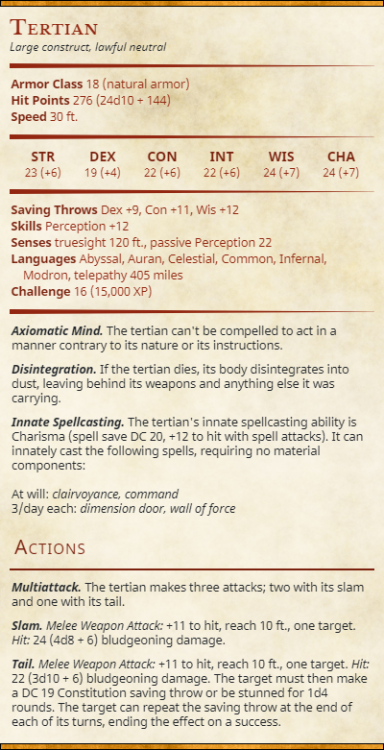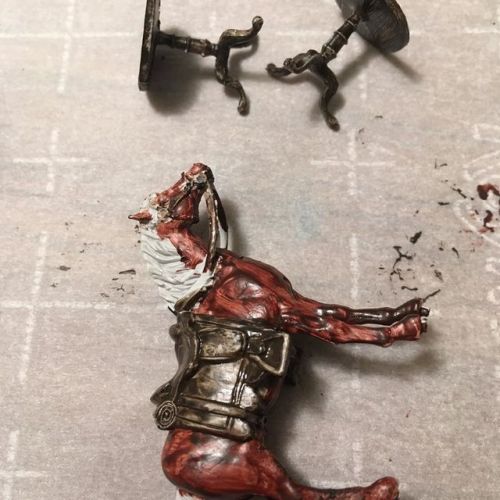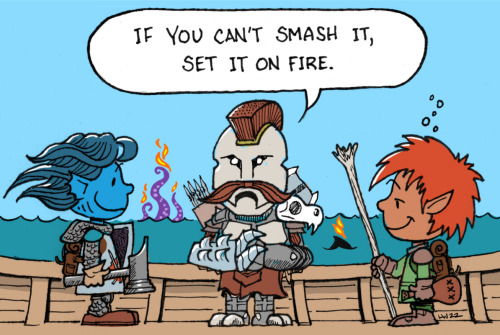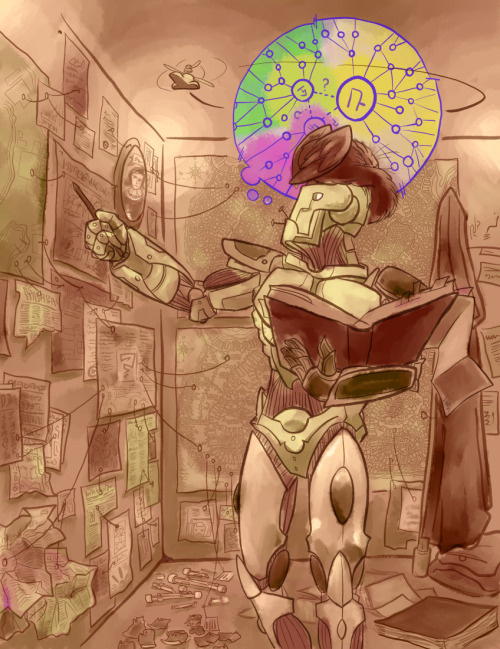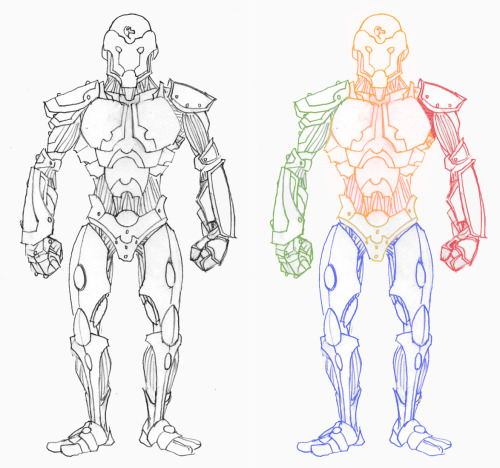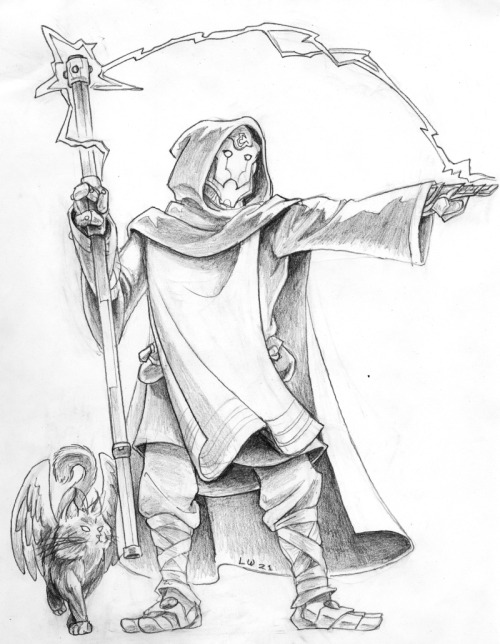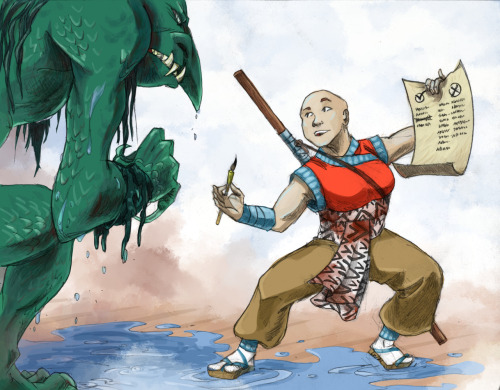#eberron
Camptosaurus is the most populous species in all of Talenta. While not as diverse or large as the sauropods, they make a successful living by cleaning up after them. Behind the usual gamut of high-browsers which keep the trees from taking over the plains are bison-like herds of camptosaurus browsing on the mid-level vegetation left in their wake. The long, pillar-like legs of the sauropods make bending down an exhausting challenge, so they leave quite a bit for them. Herds can be up to 15,000 members strong and current estimates place the total number alive between 20 and 30 million. While very large and robust compared to cows and deer, they rely on these numbers against the myriad carnivores of Talenta. Allosaurs and Torvosaurus normally prefer sauropods but will double-back to hunt the smaller camptosaurs if need be. Near forests Ceratosaurus will not hesitate to deliver unseen strikes. But the most regular hunters are Marshosaurus and halflings. Smaller than the ginormous sauropods but still large enough to put up a fight, camptosaurus are the primary food-source for most nomadic halflings. Since time immemorial their life-cycles have been intertwined. When the wet season comes, halflings enter a period where hunting is taboo (unless in self-defense), to allow their prey’s numbers to rise once more. Their striped hides are adapted in almost anything made of leather, from tents to saddles to scrolls. Their nature as a facultative biped has also worked its way into their traditions. When going on two legs the camptosaurus is free-game, and when on four legs (normally done to eat or drink) it is considered worse. Its meat will be forever tainted because it was killed in the coward’s position. Hunting camptosaurus is the main method of food acquisition among halflings, also leading to dietary changes. Almost all of their flesh is red meat. Because of this, halflings have an incredibly high tolerance to red meat and usually do not see the health risks associated with it. Camptosaurus is not a domesticated animal, however. Though entwined in their life and death, halflings have never taken them from their herds to breed them. To their minds, it would be an undeserving fate. Hunted wild the beasts can prove their merit in combat. Halfling animal-worship places much importance on the dignity of their bestial neighbors.
Physically similar to camptosaurus, Uteodon is marked by few, noticeable quirks that make it unique. Somewhat larger than their cousins, they possess darker, duller hides and live lonesome lives. Uteodon do not live in herds. Instead they inhabit the forest edges, making equal use of the trees and mid-growing ferns. Halflings consider them to be the camptosaurus’ evil cousin because of their other major difference: their temperament. Uteodon rely on their size and bulk to dissuade predators, but sometimes they need a little extra help understanding. They will bowl over predators in blind charges regardless of whether or not they were looking at the herbivore. Only those too nimble to escape or too large to truly knock over are spared. Which includes the Talenta riders. When hunters see a Uteodon among a herd of camptosaurus, they consider it a bad hunting day. They know it will fight the hunters if they try to hunt anything near it. Smaller camptosaurus herds actively encourage the presence of a single Uteodon in their ranks to defend the rest. Offering a bull first-dibs on any food and water is likely to make it happen. Still, they are rowdy and cantankerous; it’s just as possible they’ll be driven from a herd for accidentally killing a calf. Uteodon-Camptosaurus hybrids are uncommon. They tend to be larger, with dark bodies and dark stripes, and inherit their Uteodon parent’s temperament, but with a better social instinct.
Well, that was a bit of a pause between this and the last Talenta fauna. Anyways, if it wasn’t obvious, Camptosaurus is at the top and Uteodon is at the bottom. Both references come from Scott Hartman. The poses are kind of lazy, but in my defense I haven’t drawn in like a week due to real life complications. With these done we have all of Talenta’s ornithopods (and heterodontosaurs). Where shall we be going next? Perhaps this image contains a hint ^-^
Post link
Fruitadens is an oddity among the Talenta biota, culturally and scientifically. Outside, the smallest of the herbivorous dinosaurs looks quite similar to their neighboring fastieth. Closer examination reveals some surprising features. Unlike the very similar Nanosaurus, Fruitadens has an almost complete covering of short, quill-like plumage. Especially on its proportionally long tail. The skull narrows to the jaws, showing a carnivore-like shape, with its famous heterodont dentition. The large lower canine is visible externally and serves as a reminder of its bite. Fruitadens are generalists, hanging around the wetlands and rivers in the wet season and falling back to the forests during the dry season. Plants and small animals of all kinds are eaten by the critters, and they have displayed remarkable intelligence in working out how to break open mollusc shells to get at the soft innards. Their pelts are predominantly reddish-brown with whites and greys, made up of stiffened quills ending in points. Like cats they can manually raise their pelts to seem larger and prickly. Prickly is a good word for them. Their eyebrow ridges give them a constantly peeved look, which fits with their behavior. Fruitadens act ornery to make up for their small size. They’re still much more likely to run than fight, but there are plenty of Talenta hunters who have been bitten for little more than accidental encounters. In their frail bones is a strong bite capable of nipping off fingers. Their attitude, appearance, and habitat of the forests of Talenta have earned them a bad reputation among the halflings, who regard them the same way the average Aundairan would regard a skunk, with a bite instead of a stink. They are not entirely without merit though. Their quills are sought after by the few scholars of the Plains as, in the absence of geese and swans and the normal sort of traveling traders, their quills are the only options for pens, and they make rather sturdy ones at that.
Post link
Nanosaurus make up the majority of the small, antelope-like positions in Talenta. They are not particularly social, but do hang around larger herbivores when eating or sleeping. They are the quickest and most perceptive of the fastieth. Killing one and wearing its pelt is considered a mark of a hunter’s speed and keen eye. Nanosaurs are jumpy like deer, able to leap about 6 feet in the air and out-speed any other fastieth by a country mile. Being able to outrun predators means these fastieth live all about the plains, dry and wet season. They make their presence known by their distinctive scent, somewhat like fish oil. Nanosaurs rarely go into the forests, where their feet are not so sure as on the flat ground. The single variety that does live in forests are smaller and quieter, with stout legs and demure pelts. During the dry season they breed, markedly different from other fastieth. They dig small foxholes with their back legs. Females with their sandy pelts hide in it and puff up the long, thin feathers on their back, disguising themselves as dry plants to protect the eggs. Several subspecies exist around the plains. One prefers the hilly, mountainous terrain around the Mror Holds and is adapted for cold climates. Another, larger one is even more adapted to the cold, sometimes encroaching on the fields of Karrnath. Those that live in the forests are noted above. The final is otherwise similar to the plains subspecies but is smaller and more brightly colored, with orange and blue facial markings in the males. Most males have slate gray plumage that may look black or blue depending on the lighting. They also have white marks, but these are unrelated to dryosaur masks. Females are a monochrome sandy color. But males actually have a better chance at evading predators. Their plumage is very different from their scaly back halves, making them look like two different animals stitched together. This throws off predators. Females don’t have such luck and are more likely to be spotted and hunted outside of the breeding season. So now a third, distinct gender is appearing in the plains subspecies, with females possessing male plumage, but not the elaborate orange dressings. They get the benefit of avoiding predators, but are often overlooked during mating. To fix this they often become aggressively flirtatious with males to get the idea across.
–
The idea was the male was being hunted, with a trap around its leg. Technically this is a recreation of the Jurassic Park Othnielosaurus, since Othnielosaurus and Drinker got lumped into Nanosaurus. Most of the scale and plumage references was taken from Kulindadromeus. How closely related it is to Nano is questionable, but in lieu of any other scale impressions it was the safest bet.
Post link
Almost finished the Hierarch Modrons. New video out today with their lore and stats.
Channel: https://www.youtube.com/channel/UCPcFsxfrenLv_Nx0oxSmBhA
Post link
First attempts at painting DnD minis last night! The paint is dry now and I kinda like how magical that horse looks from the brushstrokes #dungeonsanddragons #dnd #miniaturespainting #eberron
https://www.instagram.com/p/ByaftjAlee5/?igshid=k0jcia06wja1
Post link
The wisdom of our seafaring Eberron DND party’s warforged barbarian, based on this item. The other two characters are the water genasi priest of the Devourer (who would add, “but whether it’s broken or on fire, just throw it into a hole for the Devourer”) and the drunk wood elf druid of the coast (who believes you should start with, “If you can’t drink it, then smash it.”)
Post link
It’s a giant centipede. I was gonna add background details, but I don’t have the wherewithal to make that happen right now. So here’s a giant, angry, hungry centipede floating in positive space.
And by giant, I mean, not the giant Amazonian centipede from IRL that this is based on, but something on the scale of a short bus. Background details might have given you that sense of scale, huh? Oh well.
Post link
Six, the warforged barbarian, reaching into an air bubble surrounding a underwater sanctuary, and is surprisingly disappointed that his sharp pointy hand didn’t burst the bubble and cause the sanctuary to flood.
Post link
Cypress the elven coastal druid, looking up, his hand raised as if to touch something or wave? Not sure. He has wild unkempt hair tied back in a bushy ponytail, and is wearing leather armor and a backpack.
Post link
Tagashi, a water genasi and smith of explosive kraken harpoons. Tagashi has short cropped hair that moves with the water, and is wearing a heavy apron and work shirt for working at a forge.
Post link
One last post about my favorite crazy Warforged, Razed, this time with his crazy wall
Razed the Warforged stands in front of the conspiracy board/crazy wall he’s building. He’s trying to figure out the plots and machinations that his group kept being involved in or stumbling across. He’s got maps of the city, graveyard complex, and outlying areas, portraits of preeminent peers, newspaper clippings, posters, wanted notices, floorplans, and even the wrappings for fish ‘n’ chips with cultist writings on them. On the floor are body parts of disassembled Warforged that he’s collected from the middens and collated in a grisly forensics exercise. A web of string and tacks links everything together across the walls, with a book full of notes and clippings collects all of his ideas.
The whole enterprise is slowly driving Razed crazy: the evidence, once black and white, now full of sepia tones, is all coming together in his head in a riot of colors. If only he could link the big three identities together, Razed could prove his conspiracy to the world!
As Razed doggedly works this out, his winged cat familiar, Cowl, sleeps on his head, while his mechanical flying nose circles above his head.
Post link
Razed, the Warforged abjuration wizard, casting Witch Bolt, while Cowl, the tressym (flying cat) familiar, watches with interest.
Razed is a remade Warforged, cobbled together from different bodies (brass head and torso, bronze right arm, blued steel left arm, and adamantine legs). Over the course of time, he sees other warforged remade with purple bishyk, who are working for the Big Bad. The bishyk Warforged conspiracy slowly drives him mad and twitchy about the color purple.
Post link
Another view of Razed the Warforged wizard.
Razed is unique among Warforged. He was cut down on the battlefield during the Last War and then resurrected (some time later by beings unknown) using the body parts of other models of Warforged. His head, torso, and pelvis are original, while his left arm, right arm, and both legs came from other models of Warforged soldiers. The revival process obliterated all memories of his former life, so he took the name Razed as his new designation.
Post link
Razed the Warforged Wizard and his familiar, Cowl
Razed traces an arc of electricity from his metal staff with his left hand, ready to unleash a Witch Bolt on some villain. His familiar, Cowl, a Tressym (flying cat), watches with interest.
Post link

Hal the warrior/calligrapher!
Hal is an oversized blonde, tanned human surfer dude warrior who’s excellent at calligraphy. Pen and sword are equally mighty in his hands! Hal’s doing the labels for a map one of the other adventurers created, and has the form and stance down 99%, except for the sticking-out-his-tongue part that his instructor just. Could. NOT. train out of him.

Abbey the Disaster Genasi.
Abbey is a water genasi and priest of the Devourer. Not content to simply observe disaster already in progress, Abbey is causing his own. He’s calling lightning from a storm (magically provided by the Devourer) down upon a group of street thugs, blasting them 10’ backwards. He also has a modified dagger that attracts lightning - surprisingly not cursed - which he throws near the action to hit even more people with lightning.

A kraken spawn, a juvenile version of the full size monstrosities that dwell at the bottom of the deep seas and oceans of Eberron. A kraken spawn looks like a giant squid, but has seven main tentacles, five smaller tentacles around its massive bone-crushing beak, multiple eyes, and a spiked carapace - etched with arcane runes - over the top of its body.
My DND group discovered what they’re like when one of these pulled itself aboard our ship and tried to drag us into the ocean depths in honor of the Devourer. We surprised ourselves by killing it and its attendant dark tritons.

A symbol of the Kraken cult of the Devourer, from Eberron.
The standard symbol of the Devourer is 5 bones, sharped into spikes, arranged loosely in a 5 pointed star pattern. They’re placed in front of a smudged field of brown with a bare ragged strip through the center.
This version, used by the followers of the Kraken, has five dark pink tentacles instead of bone spikes. The smudged field of brown has been replaced with two similar shapes of dark blue-green ink, which are light at the top and deepen at the bottom.

A dark triton from an Eberron DND game, wielding a trident and wearing pale crab chest and shoulder armor. Tritons, unlike merfolk, are mostly humanoid, with blue-green skin, fins along their forearms and calves, and webbed hands and feet. Dark tritons have tentacles from the waist down.
This dark triton worships the Ancient Deep Ones (kraken), so I gave it more bulbous eyes, a ridged forehead and nose, and arcane runes carved into its skin.
Dark tritons are considered cursed, but maybe it chose this life for itself? The deep ocean is a scary place, folks ally themselves with whoever looks the most powerful.
Rex, the elemental monk, has confused a sea troll that boarded a ship by asking if the troll came to negotiate. Rex always like give an enemy the opportunity to negotiate before coming to blows, because the tactic has worked three- no sorry, two times of the countless battles she’s gotten into. Both times have fed her boundless optimism that enemies might want to talk it out, if given the chance - and enough gold.
Post link
Cypress, the drunk wood elf druid, and his Conjured giant octopi bodyguards. His staff is his arcane focus, but he almost never casts a spell without his wineskin. The conjured giant octopi are fey spirits, keen for the opportunity to act like mortal creatures, except they don’t always behave the way actual creatures would.
Post link


